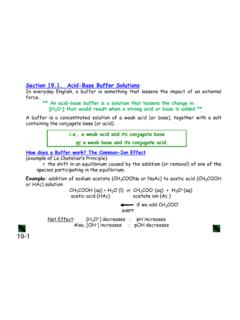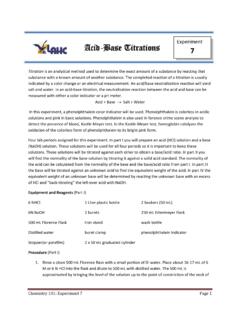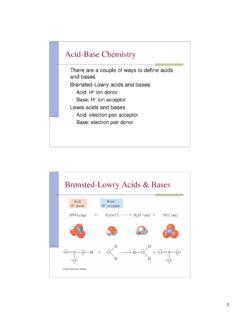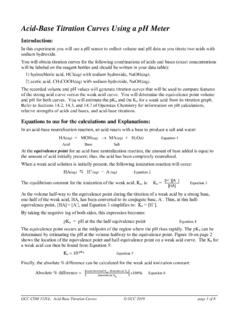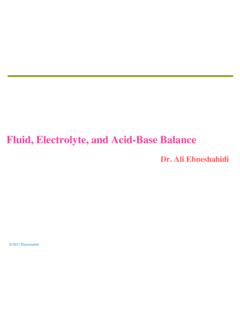Transcription of Acid-Base Physiology - PEDSCCM.org
1 Acid-Base PhysiologyBuffersH+A-HCO3-CO2 BuffersH+ A-CO2 CellsBloodKidneyLungsFluids, Electrolytes, and Acid-Base Status in CriticalIllnessLaura Ibsen, Gas Analysis--Insight into the Acid-Base status of thePatientThe blood gas consists of pH-negative log of the Hydrogen ion concentration: -log[H+].(also, pH=pK+log [HCO3]/ x pCO2). The pH is always a product of two components,respiratory and metabolic, and the metabolic component is judged, calculated, or computedby allowing for the effect of the pCO2, ie, any change in the pH unexplained by the pCO2indicates a metabolic +H0 HCO HCO+ H22233- +CO2 and water form carbonic acid or H2CO3, which is in equilibrium with bicarbonate(HCO3-)and hydrogen ions (H+). A change in the concentration of the reactants on eitherside of the equation affects the subsequent direction of the reaction.
2 For example, an increasein CO2 will result in increased carbonic acid formation (H2CO3) which leads to an increasein both HCO3- and H+ (\pH). Normally, at pH , a ratio of one part carbonic acid totwenty parts bicarbonate is present in the extracellular fluid [HCO3-/H2CO3]=20. A changein the ratio will affect the pH of the fluid. If both components change (ie, with chroniccompensation), the pH may be normal, but the other components will not. pCO-partial pressure of carbon dioxide. Hypoventilation or hyperventilation (ie, minute2ventilation--tidal volume x respitatory rate--imperfectly matched to physiologic demands)will lead to elevation or depression, respectively, in the pCO2. V/Q (ventilation/perfusion)mismatch does not usually lead to abnormalities in PCO2 because of the linear nature of theCO2 elimination curve (ie, good lung units can make up for bad lung units).
3 Diffusionabnormalities almost never are severe enough to effect CO2 elimination. Any change inpCO2 will effect the equilibrium reaction of CO2 and H2O and will effect pressure of oxygen. 2 HCO-concentration of bicarbonate ion3-TCO-total CO2=dissolved CO2 + HCO3-2 SaO-oxygen saturation, calculated2pH, pCO, and pO are the primary measurements of the blood gas terms that are used when discussing blood gas analysisBase deficit or excess--the difference between a patients measured serum bicarbonate leveland the normal value of 27 (bicarbonate plus carbonic acid ). A way of characterizing theacidosis or alkalosis. It is a nonrespiratory reflection of Acid-Base gap--Cations (sodium plus potassium) minus anions (bicarbonate plus chloride). Ifhydrogen ions accumulate, the hydrogen ion is not accounted for on the cation side, but thedecrease in bicarbonate buffer compensation would appear as a bicarb deficit, and the aniongap would acid and respiratory acidosis--Carbon dioxide is respiratory acid and is theonly acid which can be controlled by respiration.
4 When the pCO2 is high, there is a respiratory acid and metabolic acidosis--Metabolic acids are all the body s acids exceptcarbon dioxide--they are not controlled by respiration, hence they have to be neutralized,metabolized, or excreted by the kidney. Metabolic acidosis is a pH which is more acid thanappropriate for the interpretations of a blood gasNormal (pH, pCO2, pO2 and HCO3)Respiratory acidosisRespiratory acidosis, metabolic compensation (partial or complete)Metabolic acidosisMetabolic acidosis, respiratory compensation (partial or complete)Hyoxemia (with or without an acid -baseabnormality)Respiratory alkalosisRespiratory alkalosis, metaboliccompensation (partial or complete)Metabolic alkalosisMetabolic alkalosis, respiratorycompensation (partial or complete)Guidelines for interpretation of Acid-Base status)--ie, STEPS TO TAKE1.
5 What is the pH--normal, acidotic, or alkalotic?2. What is the pCO2--high, normal, or low? 3. What is the bicarbonate--high, normal, or low?4. Is the primary problem respiratory or metabolic?5. Is the problem acute, partially compensated, or compensated?A Couple rules 1. For an acute change in pCO2 of 10, the pH will change by If all changes in pH canbe accounted for by the change in pCO2, then the problem is an acute respiratory acidosis oralkalosis. If not, there is a metabolic A pH change of corresponds to a base change of 10 meq/L. This only applies to the basechanges that are not due to pCO2 changes. First apply rule 1. If there is unaccounted for pHchange, apply rule 2 to that and determine the degree of metabolic abnormality. Example--Blood gas According to rule 1 the pH should be The differencebetween the predicted and actual pH is ( base deficit).
6 Apply rule Solving for x, x=4 meq/l, which is the base deficit. Thus, there is a combined respiratory andmetabolic An immediate increment in plasma HCO3 will occur due to titration of non-bicarb buffers inresponse to acute hypercapnia. This is approximately meq/L for each mmHg increase inpCO2. 4. The only way to have a normal blood gas is to have a normal pH, pCO2, and HCO3. If the pHis normal but the pCO2 and or HCO3 are not, there is a compensated abnormality, or a mixedabnormality (ie respiratory alkalosis and metabolic aciosis). This is still abnormal and requiresattention!!!pHpCO2 HCO3 base excessAcidosisacute respiratorylowhighNNacute metaboliclowNlowlowAlkalosisacute respiratoryhighlowNNacute metabolichighNhighhighpHpCO2 HCO3 base excessAcidosischronic respiratoryNhighhighhighchronic metabolicNlowlowlowAlkalosischronic respiratoryNlowlowlowchronic metabolicNhighhighhighWhy be impressed?
7 [H+] is maintained between 36-43 nanoequivalents/L (10 eq/L)-9 Normal CO2 production is 15,000meq/day (or 15 equivalents). (adult)Nonvolatile acid load (not excreted by lungs) 1 meq/day. This acid load increases incritical illness-burns, starvation, sepsisBuffering--How are acute changes in pH buffered by the body??1. pCO2/HCO3--pK= , but pCO2 and HCO3 can be independently regulated by lungsand Hemoglobin--histidine residues. When in deoxy form, Hg can buffer more acid --CO2is transported to the lungs as Cellular and plasma proteins, intracellular organic phosphates, bone (carbonates andphosphates).Derangements of Acid-Base HomeostasisRespiratory acidosis--How?--Rise in CO2 production (fever, sepsis), or failure of ventilation (CNS causes,muscle weakness, increased dead space)For each 10 mmHg pCO2, pH falls by unitsRenal compensation-hydrogen ion secretion and ammonium secretion increasepredicted [HCO3]=(pCO2-40) + 24 Respiratory alkalosisHow?
8 -result of hyperventilation or decreased CO2 productionCauses of hyperventilation in the ICU: iatrogenic, sepsis, pain, acidemia, CNS, liver,pulmonary diseaseCauses of decreased CO2 production: sedation/paralysis, hypothermia, low carbohydratediet, brain death delta[H+] = delta PCO2, or for fall PCO2 of 10mmHg, pH rises by : renal excretion bicarbonate ion, titratable acid excretion decreasesPredicted [HCO3]=(40-PCO2) + 40 Metabolic AcidosisRenal (non anion-gap)Renal Tubular Acidosis (RTA) proximal (type II)--HCO3^15, difficult to treatdistal (type I)--less severe, can be more easily treated. Renal Failure:Complete renal failure: cant regenerate bicarb, cant excrete unmeasured anions. Bone buffers to [HCO3]=14 Acute increase in acid during critical illness can be life-threatening (previouslycompensated acidosis can become clinically important in the face of acute illness)GI Bicarbonate losses (non anion-gap)Pancreatic, bile, small intestinal fluid high in renal compensation occurs, except in the case of severe dehydration, very excessive loss (ie, cholera), or renal failureOther (anion gap)Lactic acidosisketoaciosiscongenital metabolic defects: organic acidemias, CHO metabolism defects (MCAD)Exogenous: ethylene glycol, methanol, TPN amino acidsCompensation for metabolic acidosis: Central chemoreceptors cause increasedV(alveolar minute ventilation)--increased ventilation, hence decreased pCO2= [HCO3]+8 +/- 2 Metabolic Alkalosis.
9 Initiation phase--excessive HCO3 production (net gain of HCO3 or net loss of H+)excess renal production: mineralacorticoid excess, steroids stimulate distal nephronacidification (Hions excreted, HCO3 produced)+ -vomiting/NG suction--loss of Cl- and volume--secondary hyperaldosteronism and renalacidification, plus attempt to retain volume and Na leads to Na/H+ exchange andincreased HCO3 resporbtion. (H+, Cl loss, mineralacorticoids, volume contraction all contribute)Bicarbonate, acetate, lactate, citrate administrationMaintenence phaseNormal kidneys in a normal host can excrete all filtered bicarbonateFactors which maintain alkalosis: volume depletion, hypochloremia, mineralacorticoidexcess, decreased GFRC heck urinary chloride--low in volume depletion ( chloride responsive ), high in mineralacorticoid excess ( chloride resistant )Potassium depletion almost always accompanies alkalosis (metabolic or respiratory), andmay in itself contribute to metabolic alkalosis (as K moves out of cells, H+ movesinto cells).
10 CompensationThere is some evidence that patients will hypoventilate in an attempt to compensate fora metabolic alkalosis. The degree to which a given patient or disease process is likely tocompensate not well defined. Electrolytes: Interactions with acid base and VolumeAbnormalitiesIt is important to realize that Acid-Base status, electrolytes status, and volume status interact andinter-relate, both on a purely chemical means and through the bodies homeostatic mechanisms. Magnesium: Renal loss increased with Na and Ca flux through nephron. Hyperaldosteronism,via increase Na delivery, increased Mg wasting. Calcium: acidosis increases IONIZED Ca, alkalosis decreases ionized Ca. (Hydrogen ionscompete for calcium binding sites). As the pH changes, the ionized calcium (the part that isimportant will change changes). Raising the pH (more alkalotic) causes decreased ionized Ca,lowering the pH (more acidotic) causes increased ionized Ca.

